Current Research Projects
 We present StochSS: Stochastic Simulation as-a-Service, an integrated development environment for modeling and simulation of discrete stochastic biochemical systems. An easy to use GUI enables researchers to quickly develop and simulate biological models on a desktop or laptop, which can then be expanded or combined to incorporate increasing levels of complexity. As the demand for computational power increases, StochSS is able to seamlessly scale up by deploying cloud computing resources. The software currently supports simulation of ODE and well-mixed discrete stochastic models, as well... More
|
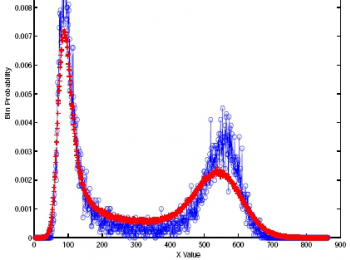 The aim of this work is to develop efficient and flexible methods for accurate modeling and simulation of intracellular biochemical processes, with target applications in biology [1] and medicine [2].
Histogram of the Schlögl model [7] based on 10,000 realizations of the SSA (blue) and explicit tau-leaping (red) methods. A deterministic simulation cannot capture the bistability of this model.
It has been established that traditional deterministic differential equation-based models may fail to capture important dynamics of biochemical systems due to the inherent randomness of the processes... More
|
 Cell polarization is a fundamental process that underlies many aspects of cell and developmental biology. In the polarization process, cellular components that were previously uniformly distributed become asymmetrically localized to create the complexity of form and function that is the hallmark of biological systems. One of the best-studied examples of cell polarization is the growth of the mating projection (shmoo) during yeast mating. Yeast cells localize specific proteins to the front of the cell in response to a spatial gradient of mating pheromone secreted by the partner. The spatial... More
|
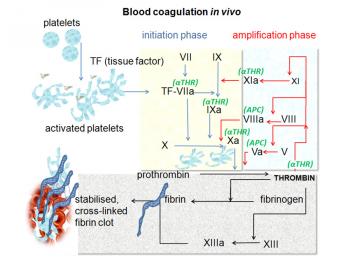 Trauma-induced coagulopathy is the catastrophic malfunction of blood coagulation after massive injuries. We investigate coagulopathy using a combination of systems biology modeling and analysis of clinical data.
The goal of our systems biology effort is to understand coagulopathy and to use this understanding to be able to predict the effects of possible therapies on patient outcome. To this end we use two approaches--bottom-up and top-down. In the bottom-up approach, we simulate a damaged blood vessel using a partial differential equation model of blood chemistry and flow (Figure 1),... More
|
 The aim of this work is to explore why brain sodium levels increase during migraines [1-3], and how these elevated levels can be normalized to treat migraines. It has been established that migraine sufferers have higher levels of sodium in their cerebrospinal fluid (CSF) and brain interstitial fluid (ISF) than control group, while there is no significant difference between plasma concentration of sodium in migraineurs and healthy individuals. This elevated brain sodium level is likely due to altered homeostasis of sodium transport mechanisms on the blood brain barrier (BBB) and blood-CSF... More
|
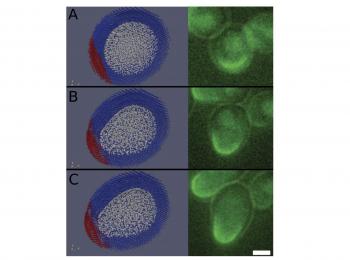 Biomechanical simulation remains a challenge for standard mesh-based numerical methods. Since these problems typically involve deforming boundaries, stochastic processes, fluid-structure interaction and conjugate transport, numerical simulations become complex, expensive and often inaccurate. An alternative to these issues is to use meshless Lagrangian methods. This class of methods, which includes Smoothed Particle Hydrodynamics (SPH) and Smoothed Dissipative Particle Dynamics (SDPD) offer attractive advantages, such as the ability to simulate free-shear flow problems with complex geometries... More
|
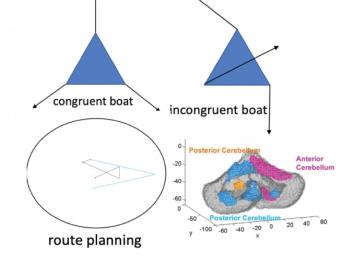 Analyzing Neural Systems that Generalize Planning Skills within a Multiscale, Hierarchical Framework Learning occurs in our daily life, such as learning a new tool, new language or taking a new route when biking home. We collaborate with Professor Grafton’s Action Lab of the UCSB Psychology Department to better understand how the brain learns. Our current project involves path planning and steering of a virtual motorboat. Subjects can choose between two set of controllers to move the boat from the start to the target point. Spatial, temporal and optimal decision learning takes place in the course of this experiment as subjects gradually master this task. fMRI scans are taken during the... More
|
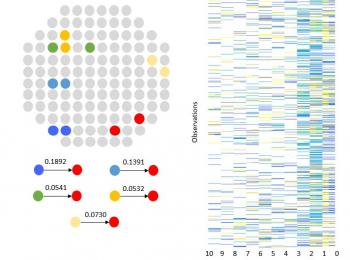 Understanding how neurons process information and interact with each other is very important for understanding how the brain processes information. Neuronal signals can be recorded with a multitude of devices. We are currently exploring neural data recorded via a multi-electrode array. A challenge of analyzing the recorded signal is how to identify single neurons. The existing spike sorting techniques have problems of inaccuracy and high computational cost. We have developed an algorithm to reliably identify propagation signals, which eminate from neurons, in each array. After identifying... More
|
